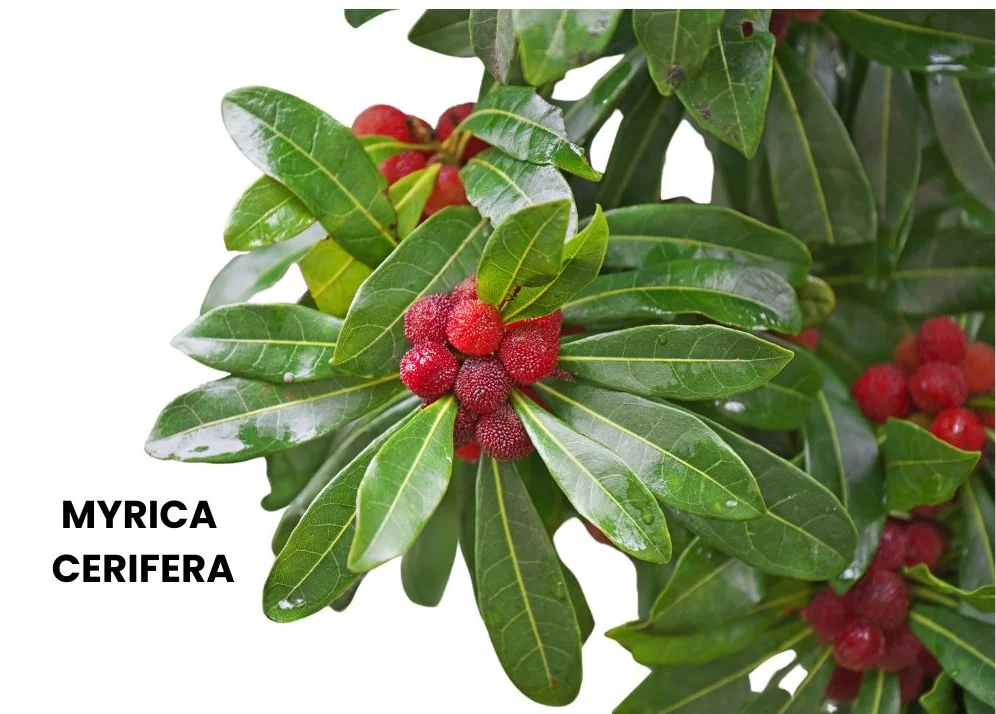Myrica Cerifera, commonly known as Bayberry, is a homeopathic remedy with significant effects on the liver, particularly in cases of jaundice and issues involving the mucous membranes.
This remedy is also noted for its role in treating persistent sleeplessness and various digestive disturbances.

SOURCE INFORMATION
Scientific Classification
- Kingdom: Plantae
- Clade: Angiosperms
- Order: Fagales
- Family: Myricaceae
- Genus: Myrica
- Species: Myrica cerifera
Origin and Historical Facts
- Origin: Bayberry is native to North America, particularly found in the eastern United States and parts of Central America.
- The plant is a shrub that thrives in sandy soils, often near coastal areas.
- Historical Facts: Historically, Bayberry was used by Native Americans for various medicinal purposes, including treating digestive issues, respiratory problems, and skin conditions.
- Its bark and berries were utilized in traditional remedies and as a source of wax for making candles.
DRUG PATHOGENESIS
- Myrica Cerifera acts primarily on the liver and digestive system, helping to alleviate symptoms of jaundice, poor digestion, and general malaise.
- It also has notable effects on the mind, causing mood changes such as despondency and irritability.
- The remedy addresses both physical and psychological symptoms associated with liver dysfunction.
KEY CHARACTERISTICS
- Liver and Jaundice: Effective in treating liver issues, including jaundice with characteristic yellowing of the skin and eyes.
- Digestive Disturbances: Addresses symptoms such as loss of appetite, nausea, and fullness in the stomach.
- Sleep Issues: Helps with persistent sleeplessness and disturbed sleep patterns.
DETAILED ORGAN SYMPTOMS
MIND
- Despondent: Feeling of hopelessness and gloom.
- Irritable: Easily annoyed or angered.
- Indifferent: Lack of interest or concern.
- Gloomy: Persistent low mood.
HEAD
- Tight Scalp: Sensation of tightness in the scalp.
- Headache: Drowsiness and aching in the eyeballs, with a feeling of pressure in the vertex and forehead.
- Morning Headache: Dull, heavy aching in the temples and forehead upon waking.
- Neck Pain: Pain and stiffness in the nape of the neck.
FACE
- Yellow Skin: Jaundice causing yellow coloration.
- Itching and Stinging: Uncomfortable sensations on the face.
- Creeping Sensation: Feeling as if insects are crawling on the skin.
MOUTH
- Furred Tongue: Coated tongue with a bad taste and nausea.
- Thick Secretion: Tenacious, nauseous mucus.
- Bleeding Gums: Tender, spongy, and bleeding gums.
THROAT
- Constricted Feeling: Tightness and roughness in the throat, constant urge to swallow.
- Stringy Mucus: Mucus that is difficult to expel.
STOMACH
- Bitter Taste: Bitter and nauseous taste in the mouth.
- Loss of Appetite: No desire to eat, but feeling of fullness after meals.
- Desire for Acids: Craving for acidic foods or drinks.
- Weak Feeling: Sinking sensation in the epigastrium, worsens after eating and improves with rapid walking.
ABDOMEN
- Liver Pain: Dull pain in the liver region.
- Jaundice: Bronze-yellow skin due to liver dysfunction.
- Abdominal Fullness: Feeling of bloating and fullness in the stomach and abdomen.
- Frothy Urine: Scanty, yellow, and frothy urine.
STOOL
- Flatus: Constant expulsion of gas, especially when walking.
- Loose Stool: Light-colored, ash-colored stool lacking bile.
- Urging to Stool: Frequent urge to defecate with significant gas release but little stool.
URINARY
- Dark Urine: High-colored, dark, frothy urine.
- Biliary Urine: Presence of bile in the urine.
SLEEP
- Disturbed Sleep: Frequent waking and bad dreams, leading to insomnia.
EXTREMITIES
- Staggering Gait: Unsteady walk.
- Muscle Pain: Pain under shoulder blades, in the neck, and in all muscles.
- Foot Pain: Pain in the hollow of the right foot.
SKIN
- Yellow Skin: Jaundiced skin.
- Itching: Persistent itchiness.
- Creeping Sensation: Feeling as if insects are crawling on the skin.
MODALITIES
- Worse: Wet weather.
- Better: Rapid walking.
WHAT ARE MODALITIES IN HOMOEOPATHY?
RELATIONSHIP WITH OTHER DRUGS
- Compare: Ptelia, Cornus circinata, Chelidonium, Leptandra, Fagopyrum.
- Antidote: Digitalis (for jaundice).
DOSE
- Tincture: Administered in tincture form.
- Third Potency: Also used in third potency.
Frequently Asked Questions (FAQs)
What conditions can Myrica Cerifera treat?
- Myrica Cerifera is effective for liver-related issues such as jaundice, digestive disturbances, persistent sleeplessness, and skin conditions related to liver dysfunction.
How does Myrica Cerifera help with digestive issues?
- The remedy helps alleviate symptoms like loss of appetite, nausea, and a feeling of fullness in the stomach, particularly after meals.
What are the key symptoms indicating the need for this remedy?
- Key symptoms include jaundice, loss of appetite, nausea, disturbed sleep, yellow and itching skin, and a general feeling of heaviness and discomfort in the abdomen.
How should Myrica Cerifera be administered?
- Myrica Cerifera can be administered in tincture form or in the third potency, depending on the symptoms and the recommendation of a qualified homeopathic practitioner.
Meaning of Difficult Words
- Jaundice: Yellowing of the skin and eyes due to liver dysfunction.
- Epigastrium: The upper central region of the abdomen.
- Flatus: Gas expelled through the anus.
- Aphthous Ulceration: Painful, small ulcers inside the mouth.
- Metrorrhagia: Abnormal uterine bleeding.
- Subinvolution: Failure of the uterus to return to its normal size after childbirth.
- Nephritis: Inflammation of the kidneys.
- Haemoglobinuria: Presence of haemoglobin in the urine.
- Hydraemia: Excessive dilution of the blood.
